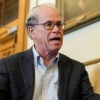As the Federal Reserve summer symposium in Jackson Hole, Wyo. begins, I thought I’d set the record straight.
The Federal Reserve cannot just set interest rates.
I’m not exactly sure how it happened, but there seems to be widespread acceptance of this idea (that the Federal Reserve can simply make interest rates whatever they want them to be).
Over the last year or so, Fed-watching journalists have routinely asked questions such as “When will the Fed raise interest rates?” And there’s no shortage of opinions on whether “the Fed should raise interest rates now.”
But the Fed really doesn’t have that kind of control over interest rates. It can’t simply make interest rates whatever it wants them to be.
The Fed certainly has limited influence over short-term interest rates, but to say it has some kind of ironclad control over rates is surely incorrect.
There’s a whole spectrum of interest rates, even in the short-term market, and the Fed has the most influence over the one that it targets: the federal funds rate.
Notably, even the Fed doesn’t claim it sets the federal funds rate. The Fed does exactly what it tells us: It sets a target range for the federal funds rate.
The federal funds rate represents the price banks charge each other to lend their reserves, and banks are free to negotiate their own terms in this market. This market is where the Fed regularly buys and sells Treasury securities to conduct what’s known as open-market operations.
It conducts these operations to push the federal funds rate toward its target, but there’s usually some deviation between the Fed’s target and the actual rate.
Among financial economists, the proposition that the Fed has only this limited influence is not too controversial. I’m certainly not the first to point out that the Fed doesn’t have so much control (influence, yes—control, no).
Janet Yellen herself, in official answers to the Senate Budget Committee’s questions for the record, stated the following:
The Federal Reserve’s control over longer-term interest rates is more indirect and more limited than its influence over the level of the federal funds rate.
Influence, not control.
Why The “All Powerful” Fed Notion Is Harmful
No single person or committee runs our economy, no matter how hard the Fed tries. Far from harmless, this notion that someone in Washington is flipping switches to control the economy—or even just interest rates—prevents Congress from imposing meaningful reforms on the central bank.
Deirdre McCloskey pointed out in 2000 that the Fed’s open market operations constitute a very small part of the world’s capital markets. McCloskey highlighted that, in a capital market of approximately $300 trillion, the Greenspan Fed typically increased or decreased its bond holdings in the neighborhood of $40 billion per year.
Worse, this fixation obscures what’s really going on.
The Fed looks at economic data and tries to manipulate the credit market based primarily on estimates of something called gaps.
One key gap is the output gap. Although this description is a bit oversimplified, the output gap is essentially the difference between the economy’s actual output and what the economy’s output would be if it were running as efficiently as possible. In other words, it’s potential output.
Of course, this potential output is not actually observable. We can only estimate it.
Another key gap is the interest rate gap.
This gap is the difference between the actual interest rate and the natural (or neutral) interest rate. The natural rate, in turn, is (roughly) the rate consistent with potential output. Of course, this rate is also unobservable.
To quote a Federal Reserve Bank of San Francisco paper:
The difficulty policymakers face is that it is not obvious exactly what the level of the neutral real rate is. It cannot be observed directly. There is no reliable way to estimate it. And it can change.
There’s more to it, of course, but basically the Fed tries to estimate these gaps and then respond accordingly. Ostensibly, if they think the economy is running below its potential, they try to stimulate it by pushing the federal funds rate below its natural rate (or at least closing the gap). If it’s running above its potential, they try to slow things down by pushing the federal funds rate above its natural rate.
All of this amounts to the Fed trying to influence credit markets to either speed up or slow down economic activity.
But interest rates and output vary around their natural rates all the time, and there’s no reason to think any one group of economists knows exactly where these figures should be. Government policies that constantly interfere with markets in this manner only distort the signals we need to make the best economic decisions we can make.
It’s hard to argue that the Fed’s discretionary monetary policy has made us safer.
The Great Depression, the Great Stagflation, the S&L crisis, and now the Great Recession have all happened on the Fed’s watch. But we’re supposed to ignore these inconvenient facts and rest assured that the Fed has learned from previous mistakes and can now fix everything.































